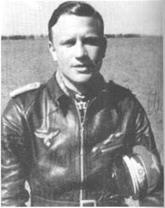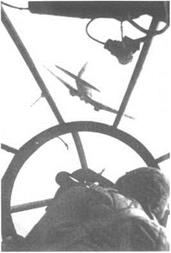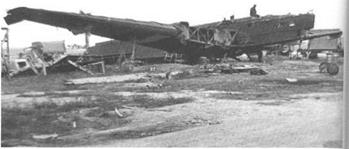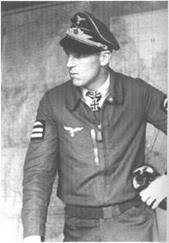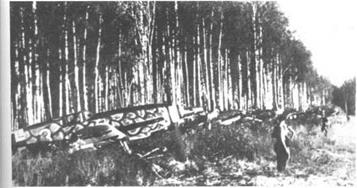Luftflotten 1 and 2 in the Struggle. for Air Supremacy
|
T |
he large-scale German air-base raids continued with almost the same intensity throughout June 23. Major Hannes Trautloft, the commander of JG 54, wrote in his diary: “We felt the exertions of the [first] day. we were all dead-tired. But it was not until midnight that we could get some sleep. Two hours later we had to prepare ourselves for the first mission of the next day.” Luftwaffe photo-reconnaissance uncovered several hitherto unknown VY’S airfields, filled with airplanes— incredibly in the same deployment as on the first day. Other German aircraft, mainly Stukas and ground – attack planes to the north of the Pripyat Marshes, struck against Soviet pockets of resistance, paving the way for the advancing Panzer formations. Meanwhile, the main task assigned to the Kampfgeschwader, apart from airbase raids, was to interdict the retreating Red Army border troops through large-scale bombings of the roads leading from the border area to the east. The aim of these raids was to create the preconditions for a surrounding of the armies in the western USSR. To the south of the Pripyat Marshes, the medium bombers of Luftflotte 4 were committed to both close support and interdiction missions. Red Army Polkovnik Ivan Fedyuninskiy recalls: “German aircraft attacked the railways and the supply lines. We suffered from a severe shortage in radio equipment, and most soldiers did not know how to handle this equipment. Orders and instructions were delayed or did not reach the troops at all. This enabled the enemy to break through our defense lines rapidly, and then they could attack our staff headquarters. Although the Germans were in control of the air, our columns undertook no measures to avoid detection from the air. Frequently, congestion of troops, artillery, vehicles and field kitchens occurred on narrow roads. Such lumps inevitably became fat targets to the enemy air force.”
The Panzer spearheads drove deep into Soviet territory, leaving large contingents of hemmed-in Soviet border troops behind them. On the second day, Generalfeldmarschall Wilhelm Ritter von Leeb’s Army Group North had reached to within ten miles of Vilnius.
The Soviet leadership was in complete disarray after the terrible events on the first day of the war. In Moscow, Stalin panicked. In the evening of June 22 he had blurted out that “All that Lenin created we have lost forever,” and then isolated himself for eleven days. General-Mayor Ivan Kopets, the commander of WS-ZOVO, committed suicide on June 23. Probably unable to grapple with its own part in the disaster, the Soviet leadership started looking for scapegoats. General-Mayor Aleksey Ionov, commander of the VVS Baltic Military District, shortly “disappeared.” All VVS commanders of the military districts that had been hit by the Luftwaffe on June 22 were replaced during the next few days. The only WS military district commander on the western borders who managed to escape persecution was General-Mayor Aleksandr Novikov, in the Leningrad Military District. He would eventually rise to command the entire WS.
During the first days of the war, the military districts were brought to a state of war, renamed “fronts,” the Soviet equivalent of the German army groups. Thus the following fronts saw daylight: Leningrad Military District-Northern Front; Baltic Special Military District – Northwestern Front; Western Special Military District – Western Front; Kiev Special Military District—Southwestern Front; and Odessa Military District—Southern Front
Most Soviet soldiers and airmen at the front refused to give in. This was the decisive factor that saved the USSR from collapsing during these early days. Any other nation’s armed forces probably would have been totally crushed by an assault of the immensity the Soviets had endured during June 22, 1941. But the Soviet airmen and soldiers proved to be tougher than most others. One of the Soviet fighter pilots at this time, Starshiy Leytenant Ivan Lakeyev, said: “During the war, I saw’ people pick up and carry a truck. Word of honor. You’d say it was impossible, but they did it. Each person had that strength, that force. Where did we find the strength? In love for our motherland.”1
This was not what the invaders had expected. A
German account from this time reads: "What has | become of the Russian of 1914-17, who ran away or | approached us w’ith his hands in the air when thej firestorm reached its peak? Now he remains in his bunker and forces us to burn him out, he prefers to be ’ scorched in his tank, and his airmen continue firing at us even when their own aircraft is set ablaze. What has j become of the Russian? Ideology has changed him!”2
Oberleutnant Hans-Ekkehard Bob, Staffelkapitan of і 9./JG 54 of Luffflotte 1, recalls the scene in the air on j the northern combat zone on the second day of the war. | In spite of the intensive Luftwaffe air-base raids on June 22, Soviet “bombers came in several waves of squadron strength against the invading German units… without interruption.” The bombers of DBA and the Northwest – ern Front made sure that the units of Luftflotte 1 had to keep struggling hard for air supremacy.
Before dawn on June 23, ten Soviet long-range bombers even undertook a daring daylight raid against the East Prussian port of Konigsberg, where they managed to hit and damage the gas works and the wharf area, і
Whereas the bombers were prepared for large-scale | action against the invaders, only a few Soviet fighters were brought into action by VVS-Northwestern Front, an effect of the Luftwaffe preemptive bombings that had struck hard mainly against the first-line fighters of VVS! Northwestern Front. Nevertheless, the aviation units of the Northern Front grouped along the entire Finnish border from Leningrad in the south to Murmansk in the Far North had been almost completely saved from air raids. Ju 88s flying without fighter escort due to the long distances to airfields of VVS-Northern Front repeatedly came under fierce attacks by Soviet fighters. The bomber units of Fliegerkorps I—KG 1, KG 76, and KG 77-regis – tered eighteen Ju 88s shot down on June 23. One of the bombers lost during the early morning hours was brought down by 158 XAP’s Leytenant Andrey Chirkov. It was the first of a total of thirty-eight victories scored during the war by this future Hero of the Soviet Union.
At about 1000 hours on June 23, sixteen SBs flew unescorted to the East Prussian air base at Gumbinnen. Although intercepted by the Bf 109s from Stab and II./ JG 54, thus losing several bombers during the approach flight, the SBs stiffly carried on, unloading their bombs from 10,000 feet. Following the raid, the formation broke up into individual flights, pairs, and single aircraft attempting to escape at tree-top level. No one returned to
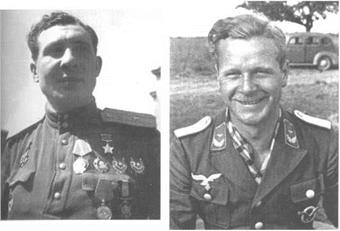 Early on June 23, 1941, Leytenant Andrey Chirkov of 158 IAP was scrambled in a Yak-1 fighter in the Pskov area. He spotted two German bombers flying about a thousand feet higher and attacked from the sun. One of the bombers caught fire from Chirkov’s first burst, and the Soviet fighter plot continued to fire until the enemy plane had descended vertically and crashed into the ground. Chirkov earned a reputation for toughness in the air and considerable flying skills. Although wounded in action twice during 1941, he survived and eventually ran up a score of twenty-nine personal kills and nine shared kills by the end of the war. Chirkov died on Septerroer 10,1956, at the age of thirty-eight. (Photo: Seidl.)
Early on June 23, 1941, Leytenant Andrey Chirkov of 158 IAP was scrambled in a Yak-1 fighter in the Pskov area. He spotted two German bombers flying about a thousand feet higher and attacked from the sun. One of the bombers caught fire from Chirkov’s first burst, and the Soviet fighter plot continued to fire until the enemy plane had descended vertically and crashed into the ground. Chirkov earned a reputation for toughness in the air and considerable flying skills. Although wounded in action twice during 1941, he survived and eventually ran up a score of twenty-nine personal kills and nine shared kills by the end of the war. Chirkov died on Septerroer 10,1956, at the age of thirty-eight. (Photo: Seidl.)
base; they were all shot down over German territory. Shortly afterward l./JG 54 ran into yet another Soviet bomber group and returned with fourteen victory claims.
At 1100, nine Bf 109s of 7./JG 54 took off on a free-hunting mission in Lithuanian airspace. Forty-five minutes later, the fighter pilots spotted a formation of nine SBs to the north of the Lithuanian capital, Kaunas. The Staffelkapitan of 9./JG 54, Oberleutnant Hans – Ekkehard Bob, leading the German formation, immediately ordered an attack. Oberleutnant Bob was one of the top scorers of JG 54 Grunherz, with twenty-one marks on his victory’ board on the eve of Operation Barharossa. Within minutes he had witnessed eight SBs being shot down in flames. Leutnant Max-Hellmuth Ostermann, bagged two.3 This short-statured twenty-three-year-old
Oberleutnant Hans-Ekkehard Bob, commanding 9./JG 54 in 1941, was one of the most daring fighter pilots of the Grunherz Geschwader. This almost cost him his life on June 23,1941, as he recalled several years later: “I adapted the speed of my fighter to that of the bomber and positioned myself 50 meters behind him. I aimed carefully and pressed the firing buttons. It worked: as I flew very slowly behind the bomber, the hits from my guns set him ablaze. As both engines and parts of the fuselage were burning—astonishingly the bomber still kept flying!—I opened the throttle to climb away beneath the bomber. Logically I passed very close to him and saw the rear gunner, eye-to-eye, just as he aimed at me and opened fire " (Photo: Bob.)
from Hamburg would develop into one of the most successful fighter aces of the war. Only one SB, piloted by the unit leader, survived. Oberleutnant Bob managed to finish this one off, but during the procedure he was himself shot down by the Soviet mid gunner. The German fighter pilot landed deep inside enemy-controlled territory but was lucky to reach German lines after two days.
The Soviet bombers kept coming in over the Lithuanian and East Prussian war zone without interruption. The pilots of JG 54 Grunherz claimed a total of thirty-nine victories before the second day of the war was over. During the confusion of combat, there were frequent occasions when Grunherz pilots mistakenly
 attacked friendly bombers. At least four KG 77 Ju 88s and one KG 76 Ju 88 lost on June 23 were shot down by friendly fighters.4 During the late afternoon a Ju 88 fired back, shooting down and killing Unteroffizier Walter Puregger of 5./JG 54.5
attacked friendly bombers. At least four KG 77 Ju 88s and one KG 76 Ju 88 lost on June 23 were shot down by friendly fighters.4 During the late afternoon a Ju 88 fired back, shooting down and killing Unteroffizier Walter Puregger of 5./JG 54.5
While large-scale air combat took place on the northern and southern combat zones throughout the second day of the war, the skies in the sector of General- feldmarschall Fedor von Bock’s Army Group Center were totally under German control. 9, 10, and 11 SAD— the cream of ZOVO—had virtually ceased to exist. The remnants of these units were pulled out of combat.
Hauptmann Gerhard Baeker of 1II./KG 1 recalls: “On June 23,24, and 25 we carried out night raids against the airfields of Essern and Riga-Spilve, which were found to be filled with Russian bombers.”
According to the Luftwaffe records, 1,357 Soviet planes were destroyed on June 23 and 24, the majority on the ground.
Launched from East Prussia against Lithuania, General Erich von Manstein’s LVI Panzerkorps had reached a hundred miles into enemy territory’ in eastern Lithuania on June 24. At that moment, the corps was struck by a heavy counterattack by a large number of Red Army – tanks, organized by General-Polkovnik Fedor Kuznetsov, the commander of Northwestern Front. Most of the aircraft remaining in WS-Northwestcrn Front were brought into the air to support the counterattack. In addition, the 1st Long – Range Bomber Corps (1 AK DBA) was dispatched to the same task. These Soviet air units were reported to have put up more than twenty-one hundred sorties during the three-day battle, suffering tremendously at the hands of the Bf 109s.
The twenty-seven DB-3As and DB – 3Fs of 53 BAP, flying against General von Manstein’s motorized columns in the Vilnius area on June 24, were intercepted by the Bf 109s of Hauptmann Max Dobislaw’s II1./JG 27 between Grodno and Vilnius. The Messerschmitt pilots claimed seven Soviet bombers shot down and returned to base without having suffered any losses. In fact, 53 BAP recorded nine DB-3s lost (including eight to Bf
109s). In the same area, Stab and I./JG 53 claimed sev – 1 enteen Soviet bombers shot down, while JG 54 recorded І another fourteen victories for the loss of one Bf 109. ]
On the ground, the Red Army’s giant 52-ton KV-2 heavy tanks armed with 152min howitzers stunned the Germans. “In a fantastic exchange of fire,” wrote the : historian of the 1st Panzer Division, “the Russian tanks I continued their advance while our antitank shells simply bounced off them.”
"Yet at the very moment of this life-and-death j struggle,” wrote Nikolai Tolstoy, “the NKVD had free use of the main railway lines linking the Baltic States і with the interior. The mass purge which they had launched on the night of June 13—14 continued as if no invasion had taken place, and truckloads of kidnapped j Balts took up much of the scanty railway system at a time when Kuznetsov’s troops desperately needed every shell and gallon of petrol they could lay hands on.’’6 |
This definitely was the summer of massacres. Fear – : ing an upsurge, the Soviet leadership ordered the evacu – ; ation or murder of all inmates of prisons threatened bv the German advance. “Thousands of political prisoners of the Left were shot, lest they offer leadership to the uprising masses.”7
ffitect firms /tfedSter

TheGcrmans-both the notorious Einsatzgruppen of the SD and ordinary Wehrmacht: soldiers—started the deliberate mass execution of unarmed civilians on June ‘ 23. Local nationalists in the Ukraine and the Baltic States took part w ith enthusiasm, killing hundreds of thousands of Jews and Communists during the following weeks and months. Two million Soviet POWs had perished in – German captivity by February 1942.” And finally, one f million to two million people were to starve to death in besieged Leningrad and in the territories occupied by the ; Germans during the coming months of the war.1’ The mass death of Soviet ground troops and bomber crews in June 1941 just fell in line with these massacres.
Bogged down by lack of fuel, General-Polkovnik Kuznetsov’s tanks became easy prey to the Luftwaffe bombers. Fliegerkorps Vlll was called in from Luftflotte 2 to break up the Soviet attack and reportedly destroyed j, 105 tanks. Particularly successful attacks were made by the Do 17s of 1U./KG 2 Holzhammer (Wooden Hammer) The commander of 9./KG 2, Hauptmann Walter
|
« |
I Bradel, was awarded the Knight’s Cross for this action.
I In the central combat zone, Panzergruppe 2, commanded by armor warfare expert Generaloberst Heinz Guderian, was advancing in a northeasterly direction along the Brest-
Minsk highway in east-central Poland on June 24. This tank thrust threatened to cut off all Soviet troops remaining in the border area at Brest.
Both sides launched strong air units to this sector. Minsk, a key point in the Soviet defense on the highway to Moscow, was almost totally devastated by continuous bombings by Luftflotte 2. But on June 24, 1941, the bomber and dive- bomber crews of Luftflotte 2 were also taught not to underestimate the Red fighter pilots. Since 9, 10, and 11 SAD had been withdrawn from combat, 43 1AD became the fighter spearhead of WS-Western Front. Based in the rear area between Minsk and Smolensk, 43 1AD had escaped the attention of the Luftwaffe air-base raids on June 22. Now, the commander of this unit, General – Mayor Georgiy Zakharov, was instructed to concentrate his fighters to repel the German air raids.
Zakharov, a famous ace from the Spanish Civil War and the conflict in China, who despite his high rank had participated in combat on June 22 (he shot down two Ju 88s), directed all available fighters to the air over the battlegrounds at Minsk. German bomber losses included five He 111 s of KG 53 Legion Condor and two Do 17s of KG 2 Holzhammer. 163 LAP,/431AD claimed twenty – one aerial victories in this area on June 24. Right above the city of Minsk, six 163 LAP 1-16s fell upon twenty-six Ju 87s of II. and III./StG 1. Led by Starshiy Leytenant Zakhar Plotnikov, a veteran from the Spanish Civil War, the Ishak pilots shot down six dive-bombers without any losses. One of the downed Stukas was piloted by the commander of Hl./StG 1, Hauptmann Helmut Mahlke. Lucky to survive, Mahlke was counted among the most able German dive-bomber pilots. He had made more than a hundred raids in France, against England, and in the Mediterranean area prior to the war with the Soviet Union. Flying over the USSR, he was shot down no less than three times within two and a half weeks.
Meanwhile, the Soviet medium-bomber units were assigned to attack Panzergruppe 2. General-Mayor Fyodor Polynin’s 13 BAD managed to get through and attack Generaloberst Guderian’s tanks in the area of Grudopole,
Pilovidy, and Ivantsevichi, halfway between Brest and Minsk. The sudden reappearance of Soviet bombers in this sector was totally unexpected by the Germans, and the SBs managed to reach the target without interference by the enemy fighters. The bombers attacked in three waves of nine bombers each as the tanks were concentrated at the crossing on the Shara River. As they inflicted bloody casualties on the ground, Oberstleutnant Werner Molders’s JG 51, which had moved forward to airfields abandoned by the VVS on the previous day, was alerted. Its Bf 109s scrambled amid the wrecks of dozens of smashed planes with red stars and rapidly climbed into the sky. An excited voice crackled in the headphones of the Messerschmitt pilots: “Mobelwagen [moving vans—the Luftwaffe code for enemy bombersl ahead!” The SBs were caught as they were turning for home. Oberleutnant Karl-Heinz Schnell, Staffelkapitan of 9./JG 51, aimed at the closest silvery bird and gave it a short burst with his 20mm cannon. The brittle aluminum bomber immediately caught fire and started to fall. Schnell turned slightly, blasted away a new salvo against a second SB, followed by another, and another. In four minutes he sent down four SBs in flames. His total score for the day ran to seven. Lcutnant Ottmar Maurer of I1I./JG 51 claimed another six.
Starting on this day, much to the astonishment of the Germans, the skies over Army Group Center were once again filled with scores of Soviet medium bombers. And once again the Bf 109s rose to meet them. The Jagdflieger found the same kind of unescorted bomber formations, and the “clay-dove shootings” started all over again. JG 51 was credited with the destruction of no less than fifty-seven SBs on June 24.
From this day on, the Jagdgeschwader on the Eastern Front maintained continous fighter patrols, their Bf 109s operating in independent Schwarm – or Rotte-size units over the tank spearheads. There were only few encounters between German and Soviet fighters as the WS fighters were operating mainly in the rear area with the task of concentrating on enemy bombers and dive – bombers and avoiding the Bf 109s. But for a couple of days there were sufficient Soviet bombers to fill the Jagdfliegers’ desire for easy hunting.
To the north of Guderian’s forces, Generaloberst Erich Hoepner’s Panzergruppe 3 reached Vilnius on June 24, the same date on which Napoleon had seized the city in 1812. Next day, III./JG 53 was transferred to the
|
|
Karl-Heinz “Bubi" (‘Little Boy") Schnell served with the JG 51 since 1939. His success as a fighter pilot began during the invasion of the Soviet Union, when he managed to shoot down four SBs in four minutes. On August 1,1941, Oberleutnant Schnell was awarded the Knight’s Cross for twenty-nine victories. He eventually rose to command III./JG 51 but was relieved from command due to sustained criticism of his superiors Schnell survived the war with a total of seventy-two aerial victories to his credit. (Photo: Schnell via Salomonson.)
large air base at the outskirts of Vilnius. There the amazed men of this unit counted fifty-six Soviet aircraft on the ground, the sad remnants of 57 SAD. Meanwhile, II./ JG 54 occupied the air base at Kaunas, where it discovered eighty-six Soviet planes, the major part abandoned undamaged, of 8 SAD.
Provided with an effective fighter shield against further enemy air attacks, Panzergruppe 2 captured Slonim and Baranovichi and thus sealed off the Soviet ground forces in the Brest area on June 25. The continued flow of Soviet bomber formations that were sent against these tank spearheads was brutally taken care of by JG 51. Claims made by JG 51 reached a new climax on June 25—sixty-eight SBs, of which one pilot, Oberleutnant Hans Kolbow, destroyed six. Farther to the north, III./JG 53 was reported to have brought down thirty-two Soviet aircraft (of which the majority were unescorted DB-3 bombers).
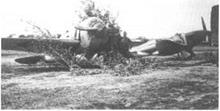
 While the Soviet counterattack in Lithuania finally broke down on June 25, VVS-Northwestern Front attempted a new tactic, concentrating its main bomber forces against the forward German fighter airfields around Vilnius. But the attempt to neutralize the German fighters on the ground backfired cruelly. The vicinity’ of the air base at Vilnius became the scene of another carnage in the air. Throughout June 25, formation after formation of Soviet bombers tried to break through and attack the airfields. Each time, they were bounced by П. and 111./JG 27. One of the German fighter pilots involved in this melee, Leutnant Gustav Langanke, succeeded in shooting down seven bombers. At dusk, the burned-out wrecks of fifty-three DB-3s and SBs—and one Bf 109— surrounded Vilnius.
While the Soviet counterattack in Lithuania finally broke down on June 25, VVS-Northwestern Front attempted a new tactic, concentrating its main bomber forces against the forward German fighter airfields around Vilnius. But the attempt to neutralize the German fighters on the ground backfired cruelly. The vicinity’ of the air base at Vilnius became the scene of another carnage in the air. Throughout June 25, formation after formation of Soviet bombers tried to break through and attack the airfields. Each time, they were bounced by П. and 111./JG 27. One of the German fighter pilots involved in this melee, Leutnant Gustav Langanke, succeeded in shooting down seven bombers. At dusk, the burned-out wrecks of fifty-three DB-3s and SBs—and one Bf 109— surrounded Vilnius.
It was mainly the cream of the Soviet medium-bomber airmen that was sacrified. In 202 SBAP, to which Mladshiy Leytenant Nikolay Gapeyonok belonged, the number of air crews was twice that of the aircraft available on the eve of the war. The most experienced aviators were selected to fly the first missions. After the first days, most of these experienced bomber crews had been killed. 9 SBAP virtually ceased to exist after the first days of combat and was withdrawn from first – line service on June 25.
The claimed score for the Luftwaffe on June 25, 1941, was 251 Soviet aircraft destroyed. At the end of the day, bomber and Stuka units returned from their missions, reporting that it was increasingly difficult to find “sufficient” amounts of undamaged Soviet aircraft to attack on the ground. Airfield after airfield had been overflown and found littered with scores of aircraft wrecks, but very few remained serviceable. Hence it was decided to shift the main mission of the horizontal bombers, Stukas, and Zerstorer from air-base raids to tactical support at the front—with devastating results for the Soviet ground troops.
The Soviet leadership desperatly tried to regain control of the situation. The High Command, Stavka, which had been formed on the second day of the war, instructed the new Reserve Front, commanded by Marshal Semyon Budyonny,
to form a rear defense line from Vitebsk on the Dvina River to Kremenchug on the Dnieper River. But constant air raids kept inflicting terrifying losses on the Red Army units, especially at the congestion of Soviet troops and vehicles at river crossings. On Thursday, June 26, the bombers and Stukas of Luftflotte 2 were concentrated in devastating attacks against the railroads in the sector assigned to the Reserve Front. The forces opposing the German Army Group Center broke up in increasing disorder, and by June 26 had ceased to operate as a cohesive whole.
The remainder of the Red Frontal Aviation’s bomber force was sacrified in senseless operations during the next few days. Fearing the reprisals that could follow from any deviation from official doctrine, the Soviet air commanders stubbornly stuck to their traditional horizontal mass-bomber attacks. Attempting to raid General Erich von Manstein’s forward Panzer columns in southeastern Latvia on June 26, a formation of SBs was completely – torn apart by the Bf 109s of 7./JG 54. Against a single loss—Leutnant Max-Hellmuth Ostermann survived a belly landing—the German fighter pilots claimed eight victories, of which Unteroffizier Karl Kempf took half.10 With this, JG 54 Grunherz had surpassed its five – hundred-victory mark.
|
|
Hav ng dealt cr ppling blows against VVS airfields ir the combat zone during the first f ve days of the war, the main attention of Luftflotte 2 was shifted against Soviet troops and I nes of communication. On Jjre 26,
1941.___ iftflotte 2 carried out no! ess than 1,072 combat sorties, mainly
against these targets. Seen from the cockpit of arothe’ aircraft of the Kette. an He 11′ is ooering its bomb run. (Photo: Galland.)
During one of the tragic aerial encounters over the central combat zone on June 26, a formation of eighty Soviet bombers was intercepted by JG 51. This cost the Soviet formation half its planes. According to Soviet sources, the DBA lost forty-three DB-3 or DB-3F bombers on June 26." 207 DBAP fared worst, with fifteen planes not returning from combat missions.
During one ol the missions carried out by 207 DBAP on this day, the first “fire taran”—air-to-ground ramming— was attributed to the bomber pilol Kapitan Nikolay (iastello. At about 1030 hours, the pilot of a DB-3 hit by enemy fire directed his damaged bomber toward a column of German vehicles on the Molodcchno – Rodoshcvichi road. (iiven significant coverage by Soviet propaganda, this action was to be emulated by dozens of
Soviet airmen during the war. Ironically, the postwar Soviet identification of the pilot proved to be wrong. Research in recent years has shown that while Gastello’s damaged DB-3 descended before it had reached the vehicles and crashed into the marshes between the villages Matski and Shepeli, another DB-3 of the same unit dived into a column of twelve German vehicles. Local inhabitants buried the bodies of the latter bomber s crew. When Soviet authorities in 1951 uncovered the grave to build a monument over Gastello, the medallion of the air gunner from another crew—that of Kapitan Aleksandr Maslov of the same unit—was found. This disconcerncd the authorities, who had created a nationwide hero’s myth around Gastello. They decided to hush up the finding, and the bodies of Maslov’s crew were buried under Gastello’s monument, while fragments of Maslov’s DB-3 were put on display at several museums as the fragments of Gastello’s aircraft.12
According to German estimates, the Soviets lost three hundred aircraft on June 26. From that day, Soviet presence in the air on the central combat zone started diminishing again. For instance, the combat record of 40 BAD (including 53 and 200 BAP) shows that no operations were flown on June 26.
Panzcrgruppen 2 and 3 met in a successful pincer movement near Minsk on this fateful Thursday. Thus a large encirclement battle started unfolding in the central combat zone.
On June 27 the two Panzer groups formed a second circle around another four Soviet armies in the Minsk area. This double encirclement was made possible mainly by the crippling pressure on the Soviet troops from the air. At this point the German bombers stepped up their blows against communication lines in the Soviet rear area, creating the conditions for a fun her enlarged encirclement battle.
Effectively covered from Soviet air attacks by the single-engine fighters of Luftflotte 2, Panzcrgruppen 2 and 3 continued to the cast on both flanks of Army Group Center. On the right flank, Panzcrgruppe 2 had already reached the Berezina River at: Bobruysk, two hundred miles inside Soviet: territory. The Soviets made a frantic effort to halt the invaders at this place.
On the evening of June 27 the new, heavily armored Soviet Shturmovik aircraft П-2 made its combat debut against this sector, but with poor results. When the war broke out, there had been only 249 planes of this model
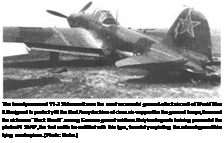 at hand, all manufactured at Aircraft Production Plant No. 18 Znamia Truda at Voronezh. The pilots of 4 ShAP had been shifted from obsolete R-Z planes to Il-2s only in June 1941. By the time the war broke out they had been trained only to take off and land this new aircraft. Knowing nothing about required tactics or combat use, and not even having fired the 20mm guns or RS rockets, they were brought into action against enemy vehicle columns in the Bobruysk area. The first mission was carried out by three Il-2s. One of them returned to base with severe damage from antiaircraft fire. Half an hour later, a damaged SB crashed into this Ilyushin, destroying it completely.15 The next day, the Bf 109s of JG 51 experienced the armored shell of the 11-2 for the first time. Against three of 4 ShAP’s Il-2s that were raiding the pontoon bridges over Berezina River at Bobruysk, the fighter pilots were stunned to see their bullets and cannon shells bounce off the agile single-engine planes. The only result was one damaged 11-2, whose pilot managed to bring it home to a safe landing. During the first three days of combat, 4 ShAP registered only two Il-2s shot down by enemy fighters, but due to a lack of experience among its pilots, a further nineteen were lost to other causes, including at least eight to AAA.14 No less than twenty of the regiment’s pilots were killed or listed as missing during these three days.15
at hand, all manufactured at Aircraft Production Plant No. 18 Znamia Truda at Voronezh. The pilots of 4 ShAP had been shifted from obsolete R-Z planes to Il-2s only in June 1941. By the time the war broke out they had been trained only to take off and land this new aircraft. Knowing nothing about required tactics or combat use, and not even having fired the 20mm guns or RS rockets, they were brought into action against enemy vehicle columns in the Bobruysk area. The first mission was carried out by three Il-2s. One of them returned to base with severe damage from antiaircraft fire. Half an hour later, a damaged SB crashed into this Ilyushin, destroying it completely.15 The next day, the Bf 109s of JG 51 experienced the armored shell of the 11-2 for the first time. Against three of 4 ShAP’s Il-2s that were raiding the pontoon bridges over Berezina River at Bobruysk, the fighter pilots were stunned to see their bullets and cannon shells bounce off the agile single-engine planes. The only result was one damaged 11-2, whose pilot managed to bring it home to a safe landing. During the first three days of combat, 4 ShAP registered only two Il-2s shot down by enemy fighters, but due to a lack of experience among its pilots, a further nineteen were lost to other causes, including at least eight to AAA.14 No less than twenty of the regiment’s pilots were killed or listed as missing during these three days.15
Even though it was operating on a diminishing scale, the Soviet bomber force refused to give in. Nineteen-year-old Leutnant Hans Strelow of JG 51 testifies to the stiff refusal to give in by the remaining Soviet bomber airmen:
Flying at an altitude of 1,200 feet, 1 closed in on the left bomber. I gave the rear gunner a couple of short bursts, then l shot the right engine in flames from a distance from sixty to twenty-five yards. Since the rear gunner had stopped firing, I flew close alongside the burning bomber. 1 saw the rear gunner raise in his little cabin.
As he caught sight of me, he shook his fist at me. Then he looked, with confusion and despair painted in his face, first ahead in the direction of the pilot’s cockpit, then at the ground,
and finally at me. The bomber was down to merely forty-five feet, giving him no choice of bailing out. His despair really captured my mind for a while. I thought: How will he come out of this? The engine is on fire, a belly landing is out of the question. To bail out would be madness. … In that moment the bomber started cutting off treetops, then the upper halves of the trees, and suddenly it lay in the woods, nothing more than a sea of flames.
Kapitan Vitaliy Gordilovskiy of 125 SBAP recalls a similar experience:
On the way to the target on June 28, my right engine was hit by antiaircraft fire. Unable to keep pace, 1 let my wingmen carry on while I lagged behind. Coming out from the target area alone, we came under attack from four Messerschmitts. My gunner opened fire. Suddenly three of the fighters broke off and turned away—I don’t know why; perhaps they had run out of fuel. But one remained and started hitting us. At first he made a frontal attack from the right, then he came up from below’. Following these attacks, he placed himself beside us, wingtip-to-wingtip. He was so close that 1 could see the pilot’s face. With a finger he signaled to me: Bail out! I showed him a

corresponding sign: No! Then he turned and hung on to my tail, and hit my plane once again. 1 noticed that 1 couldn’t hear anything from my gunner. The Messerschmitt now attacked us without meeting any resistance. His bullets slammed into the armor shield behind my back with such force that even my teeth shook. After this attack, he passed beneath us and my navigator managed to give him a burst with his machine gun pointed downward. The ‘Messer’ disappeared. 1 switched off the damaged engine and headed for the airfield. We came in directly toward the topographical tower [one of a network of special high buildings erected by the Soviets in order to facilitate mapmaking]. W’ith only one engine running, it would have been impossible to jump over it, so I switched on my damaged engine again, made a quick jump over the tower, and—plop—came down on the ground. I hit the dashboard, while my navigator was thrown out of his hatch. Smoke poured out of the engines, and the whole fuselage was
|
. ers of З ТВАР were dispatched on a fateful mission in the Bobruysk area. Only one aircraft returned.
The next day, the commander of the Soviet Western Front, General Armii Dmitriy Pavlov, and the members of his staff were summoned to Moscow, where they I were brought before a firing squad. Marshal Semyon j Timoshenko personally replaced Pavlov. All available I bomber units were instructed to attack Guderian’s Panzers J “to the last plane" to prevent the German armored units I from crossing the Berezina at Bobruysk. This was a sui – I ride order. On Monday, June 30, 1941, hundreds of I bombers of various types—SBs, DB-3s, Il-2s, Su-2s, and E TB-3s—were launched against the bridge at Bobruysk.
Coming in at around about sixty five hundred feet, I [ the Soviet bombers were met by a savage fire barrier I from the Luftwaffe’s 10th Flakregiment (AAA regiment), ]. which inevitably tore the attack formations apart. Then came the Bf 109s of Oberstleutnant Werner Molders’s j I JG 51, which had been concentrated for the defense of I this strategic key point. Within hours, 113 Soviet air – craft were shot out of the air by JG 51. All of the sixty 1 German fighter pilots participating in the air battle over J, Bobruysk scored successes. Oberstleutnant Werner j – Molders, Hauptmann Hermann-Friedrich Joppien, and і Leutnant Heinz Bar each scored five victories on this j j day, with Molders reaching his eighty-second and thus і surpassed Manfred von Richthofen’s World W’ar l top Ж score of eighty. Heinz Bar scored his twentieth victory. ■ With this, the total victory score of JG 51, the most suc-
I s cessful Jagdgeschwader at that time, surpassed the one-
II thousand mark.
The most deplorable contribution to this German j I fighter success had been given by З ТВАР. Its sluggish, : four – engine TB-3s flew doggedly into the flocks of Bf 109s. і і After two days of combat З ТВАР had lost eleven TB-3s, of which seven were shot down by German fighters.17
In the northern combat zone a similar air battle took « place over the Daugava bridges at Daugavpils in southeastern Latvia on the same day. General von Manstein’s 1 advanced armored forces of Army Group North had І managed to establish a bridgehead at this point, and metre than a hundred SBs and DB-3s from 1 MTAP, 57 BAP, and 73 BAP of the Red Banner Baltic Fleet’s 8 BAB
|
I |
were dispatched to destroy the river crossings. Coming in without escort at altitudes of up to 7,000 feet; one bomber formation after another was annihilated by the Bf 109s of JG 54 Griinherz. The first attack was directed against the airfields of 1L and Ill./JG 54 near Daugavpils. Hauptmann Dietrich Hrabak, Gruppenkommandeur in II./JG 54, reported: “At dawn they attempted to raid our base, but fortunately the bombs fell by the side of the airfield without inflicting any damage. The alert Schwarm shot down six of them right above the field. The soldiers of both Gruppen lay flat on the ground during the attack. Hauptmann [Arnold] Lignitz saw one bomber go down right in front of his tent.”18
Shortly after noon, the commander of 8 BAB dispatched the largest formation, forty SBs and DB-3s. Once again, they were intercepted by the Grtinherz fighters. Without any fighter escort, the naval bomber crews were caught in a hopeless combat, but they fought back desperately. The DB-3 piloted by Mladshiy Leytenant Petr lgashov of 1 MTAP was charged by four Bf 109s coming in from two directions. After two attacks the bomber was severely damaged and three Bf 109s closed in to deal the coup de grace. In that moment one of the fighters received the full brunt of the nose and aft gunners’ combined fire. The Bf 109 violently burst into flames and immediately went down. In spite of heavy battle damage to his airplane, Mladshiy Leytenant lgashov decided to carry on. Seconds later, four other Bf 109s moved to finish this stubborn plane. The bomber pilot realized that he had no chance of escaping and made a swift decision. Guiding his crippled twin-engine plane against the approaching enemy formation, he managed to hit the closest Bf 109 with the wing of his DB-3. Then the bomber rolled on its back and crashed right into a concentration of vehicles on the main road below.
From the German point of view, Major Hannes Trautloft, the German Geschwaderkommodore, wrote:
As we reach the enemy aircraft, a wild air combat unfolds. Everywhere you can see Russian bombers go down like comets. The sky is filled with burning planes. We take a terrible toll among them. 1 attack a single Russian, apparently separated from his formation by antiaircraft fire. A long burst sets him on fire and one crew member bails out. The burning aircraft hits the ground in a wood, ten kilometers to the north of our airfield, but I’m already after the next. I fire once, twice, and flames envelop his left engine and his undercarriage opens.
He goes into a steep dive and approaches a small lake. The bomber hits the surface, bounces across
the water like a skimmed stone, is flung over the shore, and finally it crashes in the woods in a huge cascade of fire.
To the left I can see another plane being shot down, in front of me yet another. It is a horrific picture. Suddenly an Me 109 falls on its back and plunges to the earth at high speed. Apparently the pilot had been mortally wounded in the air.
As we return to base, almost every aircraft is rocking victory signs with its wings….
Four of our pilots are missing. Oberleutnant [Hubert] Mutherich, Leutnant [Peter] von Malapert, Oberfeldwebel [Max] Stotz, and Obcrfcldwebel [Georg] Kiening. Two Me 109s were observed going down. What may have become of the other two? Oberleutnant Mutherich was last heard on the radio, reporting: “I’m hit, have to belly.” Hopefully he will return.19
The triumphant Grtinherz fighters reported a total of sixty-five Soviet bombers shot down during the day, four of them by Oberleutnant Hans-Ekkehard Bob. 8 BAB recorded forty-three losses against claims by the gunners of fifteen German fighters destroyed.20
Apart from Mladshiy Ley-tenant Petr lgashov, two other Soviet bombers carried out fire tarans during the raids against the Daugava crossings on June 30—the SBs piloted by Leytenant Aleksey Glukhov and Leytenant Petr Ponomaryov, both from 73 BAP. Total losses registered by JG 54 were five Bf 109s shot down. Two pilots, Leutnant Heinrich Wachsel of 9./JG 54 and Oberfeldwebel Georg Kiening of II./JG 54 never returned. A few pontoon bridges were hit and destroyed, but the main river crossings remained intact.
The German armor could roll eastward across the Berezina and to the northeast across the Daugava without interruption. Meanwhile, the encircled Soviet armies in the central combat zone—numbering half a million soldiers—succumbed. In the air over the wide encircled areas, the Luftwaffe adopted a “free hunting” tactic. Divided into small groups of three to six aircraft on constant patrol, hundreds of aircraft from Luftflotte 2 attacked anything that moved within the encircled area. The slow-flying Hs 123 biplanes of 10.(S)/LG 2 were particularly successful during these missions. The result was a rapid breakdown of supplies and organization in the Bialystok-Minsk areas. All resistance was broken during the first days of July. More than three hundred thousand Soviet soldiers ended up in German confinement.
The Germans claimed to have shot down more than 1,000 Soviet planes between June 23 and June 30, with a further 1,700 destroyed on the ground. Soviet sources admit the loss of 1,669 aircraft in the air from June 22 to June 30,1941.2I By July 1, VVS-Western Front could muster no more than 374 bombers and 124 fighter aircraft. To a large extent, the terrifying losses in men and materiel in the Soviet bomber units can be ascribed to the conservative thinking that dominated Josef Stalin’s Soviet Union.
|
|
Major Hannes Trautlofl was one of the most able and popular Luftwaffe unit commanders of the war. With experience as a fighter pilot during the Spanish Civil War, as well as over Poland and France. Trautloft was put in charge of JG 54 Griinherz in 1940. He would lead this Jagdgeschwader for almost three years and documented this entire period in a highly detailed diary, which unfortunately remains unpublished. Trautloft was credited with a total of fifty-seven aerial victories and was awarded with the Knight’s Cross. He died on January 12,1996. (Photo: Trautloft.)
|
Bf 109Fs of II./JG 54 warming up the engines before take off at an advance airstrip near Sarudinye in the summer of 1941. The Bf 109 had excellent aerobatic characteristics and was marvellous in fighter combat. Its stall characteristics saved the lives of many new pilots, and it could out-climb and out-dive most enemy aircraft. On the other hand it was most difficult to handle on the ground. "Most greenhorns put their Bf 109 on the nose during landing,” recalls Alfred Grislawski of JG 52. The aircraft closest to the camera, Yellow 3, was piloted by Hauptmann Franz Eckerle, famous as an aerobatic pilot before the war. Eckerle was awarded the Knight’s Cross after attaining thirty victories on September 18,1941. (Photo: Trautloft.) |
|
Luftwaffe pilots and ground crew inspect the sad remains of a destroyed SB bomber. The 360- and 400-liter wing tanks of the SB lacked armor protection and thus very easily caught fire when hit by gunfire. The forehead core cooler and the three-blade variable-pitch VISh-2 propeller reveals that this SB was an eariy version, equipped with either an 860-hp M-100A or a 960-hp M-103 engines. These versions were delivered between late 1936 and 1938. (Photo: Balss.) |
Historian Alexander Boyd noted: “Shock and confusion combined with disrupted communications and the paralyzing reluctance of local commanders to take any kind of independent action aided the Luftwaffe greatly. There was no tradition of personal initiative at junior command levels to cope with this kind of crisis, and the most obvious and elementary measures were often neglected by officers who did not know or did not dare to act independently. As late as 9 July, when the Luftwaffe had already given ample proof of its ferocity and effectiveness, divisional and regimental air commanders had to be instructed from Moscow to base no more than nine to a dozen aircraft on any one airfield, to disperse and conceal aircraft immediately after they landed, to provide trenches for shelter during air raids, and to prohibit personnel and vehicles from crossing the open airfield or congregating on it. One legacy of the past four years was that officers were more afraid of the NKVD than of the Germans.”22
Only under the brutal lashes of the German war machine were the shackles eventually broken, and the well-known Russian ability to improvise and adapt to new situations was able to spread to the armed forces.











